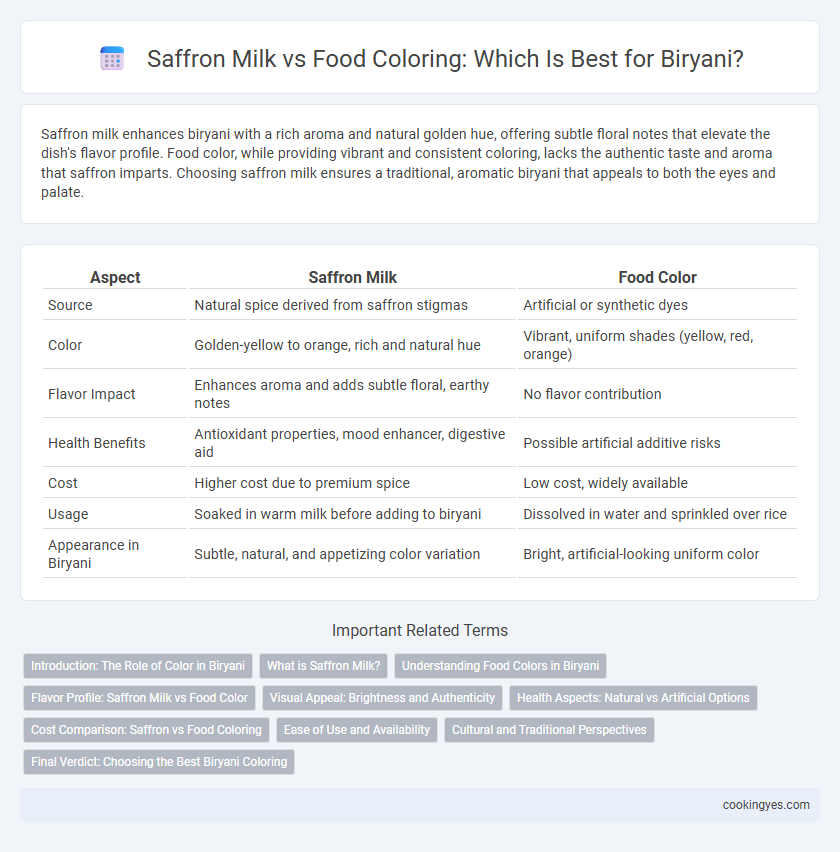Saffron milk enhances biryani with a rich aroma and natural golden hue, offering subtle floral notes that elevate the dish's flavor profile. Food color, while providing vibrant and consistent coloring, lacks the authentic taste and aroma that saffron imparts. Choosing saffron milk ensures a traditional, aromatic biryani that appeals to both the eyes and palate.
Table of Comparison
| Aspect | Saffron Milk | Food Color |
|---|---|---|
| Source | Natural spice derived from saffron stigmas | Artificial or synthetic dyes |
| Color | Golden-yellow to orange, rich and natural hue | Vibrant, uniform shades (yellow, red, orange) |
| Flavor Impact | Enhances aroma and adds subtle floral, earthy notes | No flavor contribution |
| Health Benefits | Antioxidant properties, mood enhancer, digestive aid | Possible artificial additive risks |
| Cost | Higher cost due to premium spice | Low cost, widely available |
| Usage | Soaked in warm milk before adding to biryani | Dissolved in water and sprinkled over rice |
| Appearance in Biryani | Subtle, natural, and appetizing color variation | Bright, artificial-looking uniform color |
Introduction: The Role of Color in Biryani
Color plays a crucial role in biryani, enhancing its visual appeal and signaling the blend of rich flavors. Saffron milk imparts a natural, aromatic golden hue that elevates the dish's authentic taste profile. In contrast, food color offers vibrant, uniform shades but lacks the subtle fragrance and health benefits of saffron.
What is Saffron Milk?
Saffron milk is a fragrant infusion made by soaking saffron strands in warm milk, releasing its natural golden hue and distinct aroma. Unlike artificial food color, saffron milk provides natural coloring and enhances the flavor profile of biryani with subtle floral and earthy notes. Its rich antioxidant properties and delicate taste make it a healthier and more authentic choice for vibrant biryani presentation.
Understanding Food Colors in Biryani
Saffron milk imparts a natural golden hue and delicate aroma to biryani, enhancing its rich flavors with subtle floral notes that synthetic food colors cannot replicate. Food colors, often artificial, provide vibrant and uniform coloration but lack the depth and authenticity saffron delivers, potentially affecting the overall taste and quality. Understanding the difference between these coloring agents helps in achieving a visually appealing biryani while preserving its traditional essence and gourmet appeal.
Flavor Profile: Saffron Milk vs Food Color
Saffron milk imparts a rich, aromatic flavor with subtle floral and honey-like notes, enhancing the overall taste of biryani with its natural essence. Food color, while ideal for achieving vibrant hues, lacks any inherent flavor and does not contribute to the biryani's sensory experience. Using saffron milk elevates the biryani's complexity, making it a preferred choice for authentic and flavorful recipes.
Visual Appeal: Brightness and Authenticity
Saffron milk imparts a natural golden-yellow hue to biryani, enhancing its brightness and delivering an authentic visual appeal that reflects traditional culinary practices. Food color provides a more intense and uniform shade but often appears artificial and less vibrant in comparison. Using saffron milk not only elevates the biryani's aesthetic quality but also ensures a genuine and appetizing presentation.
Health Aspects: Natural vs Artificial Options
Saffron milk, derived from natural saffron strands infused in warm milk, offers antioxidant properties and essential nutrients, enhancing biryani's flavor and health benefits without synthetic additives. Food color, commonly synthetic dyes like tartrazine or sunset yellow, may contain harmful chemicals linked to allergies and hyperactivity, posing potential health risks when consumed regularly. Choosing saffron milk ensures a natural, safe option for biryani coloring, promoting both vibrant appearance and wellbeing.
Cost Comparison: Saffron vs Food Coloring
Saffron milk significantly increases biryani preparation costs due to saffron's premium price, often exceeding $500 per pound, while food coloring averages less than $10 per bottle, offering an economical alternative. Although food coloring provides vibrant hues at a fraction of the cost, saffron milk enhances flavor and aroma, justifying its expense in gourmet recipes. Choosing between them depends on budget constraints and desired authenticity in biryani presentation.
Ease of Use and Availability
Saffron milk offers a natural and aromatic coloring option for biryani but requires soaking and is relatively expensive and less readily available compared to food coloring. Food color provides a more convenient and cost-effective alternative, easily accessible in most grocery stores and allowing quick and uniform application. Choosing between saffron milk and food color depends on the balance between authentic flavor enhancement and practical ease of use.
Cultural and Traditional Perspectives
Saffron milk holds deep cultural significance in biryani preparation, symbolizing purity and luxury rooted in centuries-old culinary traditions. Its natural aroma and golden hue enhance the sensory experience, reflecting authenticity that artificial food colors cannot replicate. Traditional recipes prioritize saffron milk for its health benefits and cultural reverence, making it a preferred choice over synthetic coloring agents in heritage biryani dishes.
Final Verdict: Choosing the Best Biryani Coloring
Saffron milk offers a natural and aromatic coloring option for biryani, enhancing both flavor and visual appeal with its golden-yellow hue and subtle fragrance. Food colors provide a more vibrant and consistent appearance but lack the rich taste and health benefits associated with saffron. Choosing saffron milk ensures an authentic, flavorful biryani, making it the preferred choice for culinary excellence despite its higher cost.
Saffron Milk vs Food Color for Biryani Coloring Infographic

 cookingyes.com
cookingyes.com